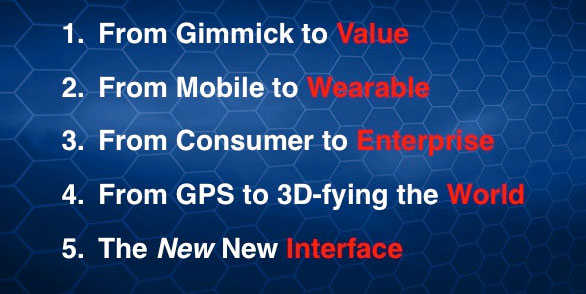Here are my top 5 trends in the interactive world to experience at AWE 2014 next week in Santa Clara: From Gimmick to Value The first trend we noticed in the past year is that Augmented Reality has made a transformation from a gimmick to a valuable solution. From a girl jumping on a marker – to applications that help in retail, healthcare and sports, training, entertainment, and many other fields that are being revolutionized with AR and Wearables. From Mobile to Wearable The iPhone and Android smartphones enabled the masses to experience AR for the first time. And once we experienced it – we wanted more. For years we have been waiting for real AR glasses to arrive that will unleash AR experiences at an order of magnitude better – hands free, always on, making us better at anything we do. 2014 is Clearly the year of the Wearable with Glass on everyone’s mind (which BTW is good, bad and sometimes ugly for the industry – but overall great). And even more fascinating is the numerous companies launching AR smart glasses this year: Vuzix, Epson, Meta, Optinvent, Atheer Labs, Laster… But we have to remember these are 1.0 products (some would say beta), and Mobile platforms will continue to serve the majority of AR experiences for another couple of years until glasses reach the inflection point. From Consumer to Enterprise This is the most significant trend I am seeing this year. The industry is clear eyed, and recognizes that until the masses adopt glasses in a few years – the big revenue drivers are currently in the Enterprise. Enterprise AR is exploding with projects spanning from training, to warehouse picking, to the field service, to security, and many other areas which are driven by fortune 1000 companies’ who must find new ways to improve business processes: GE, Raytheon, Walmart, Boeing, Verizon, are among these big names who are investing funds and talent in these initiatives. Having said that many valuable consumer applications will continue to delight users in the coming years and eventually will become as big a market as for smartphones. From GPS to 3D–fying the World The first AR demo on a smartphone in 2008 showed a castle on a hill in Austria with an info bubble extracted from wikipedia. That was based on GPS and it wowed the world. But when trying it in urban areas – or worse indoors – many realized GPS is not accurate enough and it significantly detracted from the experience and turned people away. With recent technological advances all of a sudden you and I can have in our hands the tools to map and sense the world in 3D. 3D depth cameras, miniature lasers, motion, sound, and signal sensors are tracking us and our surroundings and enable computers to see and understand the world more accurately than ever. This is a hugely important factor to make the world a more interactive place! The New New Interface All of the above trends are ushering the biggest change of all – computers are disappearing onto our bodies and into the environment and a new interface is emerging. Multi touch was heralded a few years ago as the new interface. But when you break away from the screen, beyond touching a limited 2D surface – there is a potential for a much more intuitive experience. Today, we are so oblivious to our surroundings. Not to mention we bump into things when texting while walking. Computers rarely activate our brains to look around. And yet, the need to interact with the real world is in our bones. We crave to “click” on: people, places, and things. Our job is now to invent this new interface, and it’s definitely not HCI (Human Computer Interaction) which has been studied for 40 years. We have to leave the old metaphors behind. I believe it’s a new domain in design that should be thought of as HWI – Human World Interaction. Let’s join forces in the pursuit of this new new interface! And that wraps up my top 5 trends to expect at AWE 2014. What are your top 5? There is probably no better place to experience these trends in action than at AWE 2014: 100 talks by 150 industry innovators, hundreds of demos by leading startups and major corporations, and connecting with 2000 like-minded professionals working hard to make the world a more interactive place. It will be AWEsome. See you next week in Santa Clara California!...









